
The garden pansy is a type of polychromatic large-flowered hybrid plant cultivated as a garden flower. It is derived by hybridization from several species in the section Melanium of the genus Viola, particularly V. tricolor, a wildflower of Europe and western Asia known as heartsease. It is sometimes known as V. tricolor var. hortensis, but this scientific name is suspect. While V. tricolor var. hortensisGroenland & Rümpler is a synonym of Viola × wittrockiana, V. tricolor var. hortensisDC. refers to a horticultural variety of wild pansy that had been illustrated in Flora Danica in 1777 before the existence of Viola × wittrockiana.
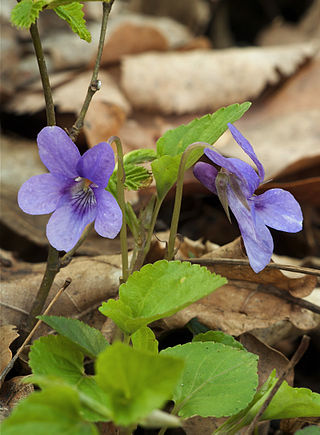
Viola is a genus of flowering plants in the violet family Violaceae. It is the largest genus in the family, containing over 680 species. Most species are found in the temperate Northern Hemisphere; however, some are also found in widely divergent areas such as Hawaii, Australasia, and the Andes.

Teide, or Mount Teide, is a volcano on Tenerife in the Canary Islands, Spain. Its summit is the highest point in Spain and the highest point above sea level in the islands of the Atlantic. If measured from the ocean floor, its height of 7,500 m (24,600 ft) makes Teide the third-highest volcano in the world, and is described by UNESCO and NASA as Earth's third-tallest volcanic structure. Teide's elevation above sea level makes Tenerife the tenth highest island in the world.

Viola riviniana, the common dog-violet, is a species of flowering plant in the family Violaceae, native to Eurasia and Africa. It is also called wood violet and dog violet. It inhabits woodland edges, grassland and shady hedge banks. It is found in all soils except those which are acid or very wet.

Viola hirta is a species of the plant genus Viola. It is also called the hairy violet. As with the sweet violet, no fossil seeds of this species have been found. It is confined to the cold temperate zone, in Europe, north and west Asia, extending as far as northwest India. It is absent in Wales from Brecon and Radnor, Pembroke, Cardigan, Merioneth, and from Mid Lancs, and the Isle of Man, but elsewhere it is universal. In Scotland it does not occur in Roxburgh, Berwick, Haddington, Edinburgh, Fife, Forfar, Kincardine. From Forfar it ranges to the south of England, and is found at a height of 1000 ft. in Yorks. It occurs also in Ireland.

Viola odorata is a species of flowering plant in the family Violaceae, native to Europe and Asia. This small hardy herbaceous perennial is commonly known as wood violet, sweet violet, English violet, common violet, florist's violet, or garden violet. It has been introduced into the Americas and Australia.
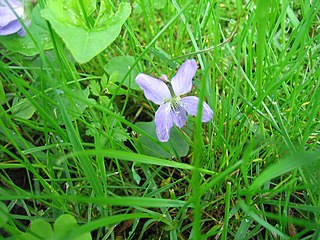
Dog violet is the common name for various species of the plant genus Viola with unscented flowers. The term arose to differentiate them from the scented sweet violet. Species so named include:
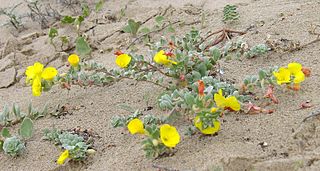
Camissoniopsis cheiranthifolia, the beach suncup or beach evening primrose, is a species of the evening primrose family and is native to open dunes and sandy soils of coastal California, Baja California and Oregon.

Viola sororia, known commonly as the common blue violet, is a short-stemmed herbaceous perennial plant native to eastern North America. It is known by a number of common names, including common meadow violet, purple violet, woolly blue violet, hooded violet, and wood violet.
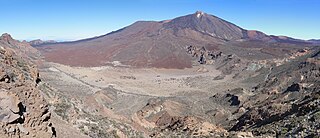
Teide National Park is a national park located in Tenerife, Canary Islands, Spain.
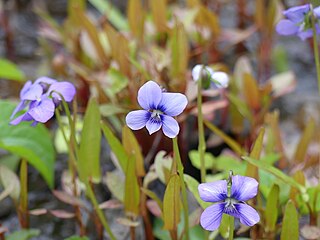
Viola cucullata, the hooded blue violet, marsh blue violet or purple violet, is a species of the genus Viola native to eastern North America, from Newfoundland west to Ontario and Minnesota, and south to Georgia. It is a recipient of the Royal Horticultural Society's Award of Garden Merit.

Viola adunca is a species of violet known by the common names hookedspur violet, early blue violet, sand violet, and western dog violet. It is native to meadows and forests of western North America, Canada, and the northern contiguous United States.
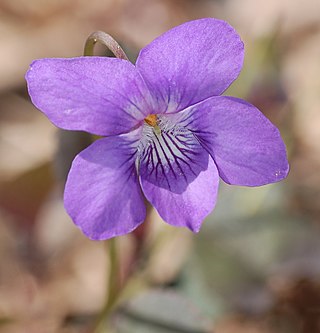
Viola labradorica, commonly known as alpine violet, American dog violet, dog violet or Labrador violet, is a perennial herbaceous flowering plant. It is native to Greenland, eastern Canada, and the eastern United States. The plant sold as Viola labradorica by nurseries is Viola riviniana.

Viola reichenbachiana, also known as the early dog-violet, pale wood violet, slender wood violet, hedge violet, or wood dog violet, is a species of flowering plant in the Viola genus. This species hybridises with Viola riviniana, the common dog-violet, to produce Viola × bavarica. The plant is named after the 19th century botanist Ludwig Reichenbach. It is a rhizomatous herbaceous perennial that is widely known for its purple petals, and it typically resides along road banks or among other rich vegetation, as other wild pansies do. The name dog violet refers to its lack of scent, making it supposedly only fit for dogs.

Viola nephrophylla syn. Viola nephrophylla Greene f. albinea (Farw.), Viola pratincola Greene, Viola retusa Greene ) is an annual or perennial forb in the Violet family (Violaceae) native to North America.

Viola selkirkii is a species of violet known by the common names Selkirk's violet and great-spur violet. It is native throughout the Northern Hemisphere, its distribution circumboreal.

Viola hispida is a plant species in the genus Viola. It is endemic in France, and more specifically in the Seine valley.
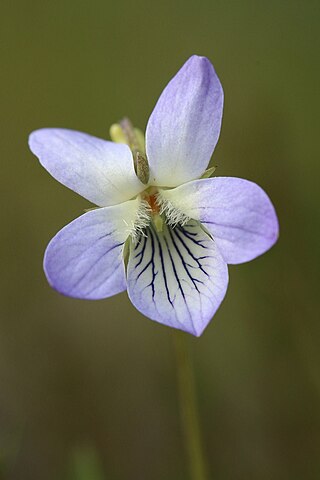
Viola lactea, also known by its common name pale dog violet, is a species of flowering planet of the family Violaceae.


















